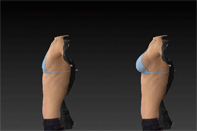One of the most common debates in breast augmentation is implant placement. Essentially there are only two categories of breast implant placement, above the muscle (subglandular) and below the muscle (submuscular) but it is more complicated than that, as both categories branch off into different surgical techniques. In this blog post, we will keep it simple and focus solely on subglandular vs submuscular.
Many women wonder if one option is better than the other, based on their lifestyle, desired appearance, breast health management.
Some women think they need to center their decision for implant placement on their workout routine or the ease of mammography screening. Before making the choice, it is best to consult with a credible plastic surgeon that specializes in breasts and can guide you through the two options to allow for a more informed decision.
Implant Placement Options: Subglandular vs. Submuscular
When it comes to breast augmentation over the muscle or under the muscle, the main difference is where the implant is placed inside your chest.
- Subglandular (Over the Muscle / Above the Muscle):
In this method, the implant is placed behind the breast tissue but in front of the chest muscle. It is a simpler, less invasive surgical approach and can minimize having aesthetic distortions associated with the mechanism of muscle tissue. - Submuscular (Under the Muscle):
Here, the implant goes beneath the pectoralis chest muscle. It is more technical, but beneficial as the muscle gives more coverage over the implant, which can help the breast look smoother and more natural and minimizes long-term tissue atrophy.
Over-the-Muscle (Subglandular) Implant Placement
With subglandular placement, the implant sits on top of the chest muscle but underneath your natural breast tissue. This method is often chosen when a woman already has a good amount of natural breast tissue to cover the implant.
What the Procedure Involves
During surgery, the doctor creates a space directly behind your breast tissue and places the implant there. Since the chest muscle doesn’t need to be cut or moved, the procedure is usually quicker and less invasive than under-the-muscle surgery.
What to Expect During Recovery
Because the muscle isn’t involved, most women feel less post-operative discomfort. There’s less tightness in the chest, and many women can return to regular daily activities sooner. That said, your surgeon will still recommend taking it easy for a couple of weeks.
Benefits of Over-the-Muscle Placement
- No implant movement when flexing the chest muscles (no “animation deformity”)
- Easier to place larger implants, especially in women with fuller breasts
- Often preferred by athletes and bodybuilders who rely heavily on their chest muscles and want larger implants
Possible Drawbacks
- Implants may be more visible or easier to feel, especially in thin women
- A higher chance of rippling, where the edges of the implant show through the skin
- Slightly higher risk of capsular contracture, a condition where scar tissue hardens around the implant
- Can make mammograms a bit harder to read, as more of the breast tissue is covered by the implant
- Can increase the risk of tissue atrophy (thinning) and impact vascularity.
Who Might Choose This Option
This method can work well for women with thicker breast tissue or more natural fat in the chest area. It’s also a common choice for those who want a very round, full look or who want to avoid the risk of muscle-related issues.
Under-the-Muscle (Submuscular) Implant Placement
With submuscular placement, the implant is positioned beneath the chest muscle. This means the implant is covered by both your natural breast tissue and your muscle, offering more support and a smoother appearance, especially in thinner patients.
How the Procedure Works
During surgery, the surgeon lifts the chest muscle and places the implant underneath it. This takes a bit more time and is slightly more complex than over-the-muscle placement.
What to Expect During Recovery
Recovery from submuscular placement often includes more soreness and a longer healing time. Since the chest muscle is elevated during surgery, you may feel tightness and muscle tenderness for the first week or two. Depending on the surgeon, most women need a little more time before returning to full workouts or lifting heavy objects.
Benefits of Under-the-Muscle Placement
- Implants are better hidden under the muscle, so they feel and look more natural
- Lower risk of visible rippling
- Capsular contracture happens less often when the implant is placed under the muscle
- Implants are less likely to interfere with mammograms, making breast screenings easier
- You can still do upper body and chest workouts as normal. Body builders, cross fitters, etc. can perform the same after surgery as before, despite the misconception that there are limitations with submuscular implants.
Possible Drawbacks
- Risk of animation deformity, where the implant moves or shifts when you flex your chest muscles
- Some women may experience temporary loss of strength in the chest or upper arms
Who Might Choose This Option
This method works best for patients that prioritize safety and aesthetic longevity.
Surgeon Recommendations & Patient Factors
Some plastic surgeons lean toward one method based on their experience or surgical style. Many recommend under-the-muscle breast augmentation for its natural look and lower risk of complications. Others may suggest over-the-muscle in certain situations to avoid animation or allow for a larger implant.
The best surgeons will recommend the most suitable option based on your unique situation, not just what’s easiest or fastest.
Which is Better – Submuscular or Subglandular Implant Placement?
Both under the muscle breast augmentation and breast augmentation over the muscle come with their own set of pros and cons. What’s right for one woman may not be the best for another.
When it comes to drawbacks with either option, the most important thing you can do is consult with a credible board-certified plastic surgeon and choose an implant that fits best with your natural tissues. Choosing the right implant for your tissue-based measurements, reduces the aforementioned drawbacks.
In the end, the best results come from a customized approach that takes into account your body type, lifestyle, and how you want your new breasts to look and feel, not just today, but for years to come.















